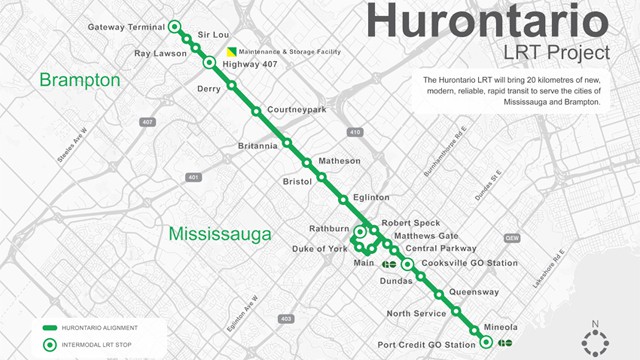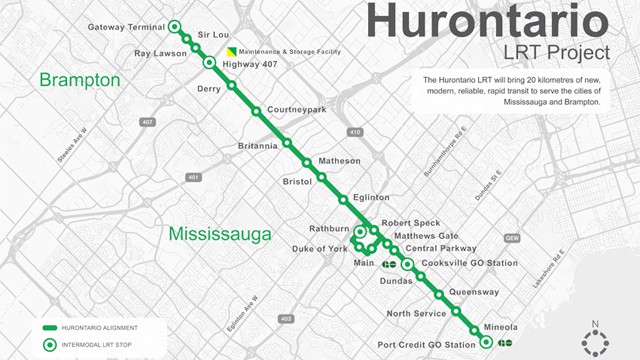What You Might Not Know About the LRT in Mississauga
Published October 24, 2016 at 12:44 am

As the countdown to the Hurontario LRT begins, proper communication to the public is crucial every step of the way.
That’s why the City of Mississauga hosted a public meeting inside council chambers last week, with more public consultations coming specifically to Wards 1, 4, 5, and 7 (where most of the LRT will run through). If you live in those wards you can check here for the time and place, so you can attend a smaller version of this meeting in your local community.
When it came time to enter council chambers for the main presentation, it was mediocre to say the least. It was literally a Powerpoint version of what was situated in the Great Hall of the Civic Centre. Councillor Nando Iannicca acted as the MC, and comments were delivered by Mayor Crombie and Ontario’s Transportation Minister Steven Del Duca. Minister Del Duca did said something very revealing and the closest I’ve heard to a politician admitting a complete truth.
“When you’re building transit after the fact it’s more difficult than starting on a blank slate from the ground up. Construction is not that fun when you live close to it.”
The general consensus is that people want infrastructure and more transit; they’re just not really happy when you start building it, no matter what design you go with. I wonder if the government had thought about the reality of human instinct and behaviour when it came to delivering on their policies.
Here are some other observations I made, some were expected but others quite revealing.

 The over-managed logistics = screening out dissent?
The over-managed logistics = screening out dissent?
The main public gathering before the presentation in the council chamber when I arrived was held in the large open area of the Civic Centre’s main floor called the Great Hall. Members of the public could mill about, observe the displays and maps, or direct questions to the experts that were working on the project.
It’s the way the organizers managed how questions were asked that was noticeable. After the presentation was over, we were all hustled back into the main foyer to continue what we were doing before; looking at info and asking questions.
Susan Walsh, an organizer, told me they were shunning the traditional format where members of the public approach the microphone and ask questions or make comments. She explained that it was a good idea because, that way, people could go ask the actual experts who could answer people’s specific questions.
It’s better than someone pontificating for 20 minutes or so while getting no real answers or having someone say they’ll get back to them. Going back into the foyer, if you have a question about architectural issues, you can ask one of the architects. If you have concerns how your property would be affected, you can ask the real estate manager. Finance guys can discuss the funding model if you have a question about that.
According to Walsh, that’s a good way to screen out people looking to hijack the meeting with rambling speeches or (dare I say it) voice open opposition to the LRT. Too many experts? Where is the accountability?
Too many experts? Where is the accountability?
Here’s the flip side to having all these experts on hand to answer questions about the LRT. While the abundance of people available to answer questions (be they architects, planners, financing experts, real estate professionals etc.) is good, it doesn’t seem there’s one or a certain number of people that could be held accountable to the answers they give to people in attendance.
If you think about this even in just the context of one single government department, there would be a plethora of people that could give you ten different answers, but at least they have a cabinet minister that can distill all that information down to a definitive answer. With this LRT public format, you can go up to five planning experts and they could theoretically give you five different answers regarding an issue with the LRT. But there isn’t one person that was present that coordinated a certain group of experts that could condense that knowledge, provide a definitive answer, and be held accountable to that answer. There is no guarantee that money is safe
There is no guarantee that money is safe
One thing that was not addressed is whether the $1.3 billion that the Ontario government has given to fully fund the LRT is locked-in and guaranteed. I spoke with Councillor Nando Iannicca, Mississauga’s longest serving councillors and a vocal LRT supporter, and he could not answer that question definitively.
Although the provincial government has pledged to fund the project, there are some “what ifs” that should be addressed. If the government changes, what happens if the new regime decides that deficit reduction is more important and decides to cancel the LRT (again)?
Let’s not kid ourselves; there is only one political party in Ontario that has ever cancelled transit projects while construction was already underway. Anyone remember when Mike Harris’ Conservatives took power in 1995? There was a subway already under construction under Eglinton Avenue in Toronto and after Harris took office, he proceeded to rebury the project (literally, the fill that was dug out for the subway tunnel was dumped back in to refill it). And only now, 20 years later, is there transit construction underneath Eglinton again.
Who’s to say that a possible future PC government under Patrick Brown wouldn’t do the same thing? Some time ago, I asked Mark Towhey, a political strategist working for the newly minted PC leader, whether a Brown government would axe the LRT in Mississauga or keep it. All Towhey did was redirect me to a website where the PC party was taking suggestions on what priorities Ontarians had; I never really received an answer back from anyone. LRT or forms of public transit other than “subways, subways, subways” have never really been an option when right leaning politicians are asked about transit issues.
Councillor Iannicca was insistent that in this day and age, from a purely political standpoint, there could not possibly be anyone stupid enough to cancel the LRT now, after all the environmental assessments, public consultations, funding announcements and work that has already gone into it. I sincerely hope he’s right, but I never underestimate the ability of those in political office to put their foot in their mouths and do something colossally stupid. No one way trip from bottom to the top
No one way trip from bottom to the top

I may have missed some previous briefings on the matter, but that loop around Square One on the LRT map confused me for quite some time. But here’s a news flash, folks: you cannot take the LRT from Port Credit all the way up to Shoppers World in Brampton if that is what you plan to do.
I asked two LRT representatives from Metrolinx how, exactly, the loop works and they indicated that based on anticipated ridership, there wasn’t enough of it to justify a one-way route from Port Credit right to the final stop at Gateway in Brampton. Most people would be heading to City Centre in Mississauga, so from both ends the LRT would convene there and go back to Brampton and Port Credit again. From Port Credit coming up north, you’d basically would have to transfer on the Rathburn station around the loop, then get on the other route that leaves Square One for Brampton. If you were coming from Brampton, the route only goes around the Square One loop and heads back up to Brampton. So coming from Brampton, you’d have to transfer at Rathburn if you final destination is Port Credit.
The experts did say that over time they could add a third route that would be a continuous one-way trip from the Port Credit to Brampton station. But I think the LRT planners left out the number of current commuters who work near the Airport region and in the industrial properties north of the 401. What if you lived in Port Credit or Cooksville and you were looking to use the LRT to travel north and get off at Courtney Park or Derry to transfer on one of the MiWay routes? When this LRT is completed, you would have to come up from the south, transfer at Rathburn onto the other LRT route, then continue on north and transfer to MiWay. That does not seem like a smooth transition as a commuter in my opinion. Private Property Expropriation for the LRT
Private Property Expropriation for the LRT
It is known as ‘eminent domain’ in the United States. They are powers that a state (or in our case a province) can delegate to municipalities, government subdivisions, or even private persons or corporations, when they are authorized by the legislature to exercise the functions of public character. In our case, for the LRT.
Metrolinx and the City of Mississauga say land is needed for the LRT so those property owners whose land lies along the LRT corridor would be contacted by Metrolinx and have the process clearly explained to them as well as the options moving forward. Down in the States, this procedure would be a little more assertive and not as friendly, so Metrolinx is looking to provide as much information and education as possible in order to have the smoothest transition for affected property owners and to avoid any messy legal battles. I doubt people would react the way the provincial transit agency wants them to, so it should make for some interesting stories down the road.
That’s all I have for now, and I would encourage everyone to attend one of the local LRT public open houses for further information and chance to ask questions.
Follow me on Twitter at @thekantastic
insauga's Editorial Standards and Policies advertising





